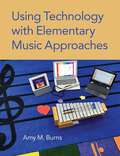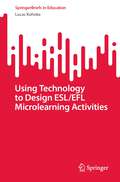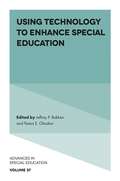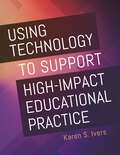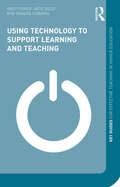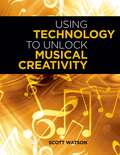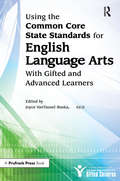- Table View
- List View
Using Students' Assessment Mistakes and Learning Deficits to Enhance Motivation and Learning (Student Assessment for Educators)
by James H. McMillanBeing wrong is an integral part of the assessment process, and understanding how to learn from those mistakes, errors, and misconceptions helps educators and students get the most from their learning experience. In this practical volume, James H. McMillan shows why being wrong (sometimes) is an essential part of effective learning and how it can be used by teachers to motivate students and help develop positive achievement-related dispositions. The six concise chapters of Using Students’ Assessment Mistakes and Learning Deficits to Enhance Motivation and Learning show how mistakes affect students’ engagement, self-regulation, and knowledge, and how teachers can most effectively contextualize supposed failures to help students grow.
Using Support Groups to Improve Behaviour
by Mrs Joan MowatIncludes CD-Rom `Joan Mowat adapts ideas about understanding, transfer of learning, and theories of mind to help restless students deal better with their responsibilities toward others and themselves' - Professor David Perkins, Graduate School of Education, Harvard University 'Mowat provides a valuable and comprehensive guide to the setting up, running and management of Support Groups as a whole-school initiative...This book would make an invaluable hand-book for anybody in a pastoral leadership role, who is interested in the organisation and setting up of support groups within a social setting' - TES Website Based on material that has been successfully tried and tested, this book provides an example of a whole school approach to setting up and managing support groups to improve the behaviour of pupils with social, emotional and behavioural difficulties. Suitable for both primary and secondary schools, the strategies in the book align with the aims of the new Primary National Strategy and Key Stage 3 Strategy on behaviour and attendance, as well as the SEAL (Social and Emotional Aspects of Learning) curriculum, the Scottish 'Curriculum for Excellence' and 'Happy, safe and achieving their potential' (the standard of support for children and young people in Scottish schools). The book explains the aims of the support group approach, and gives practical advice on: - planning for and setting up a support group - involving parents in the process - assessing pupils' progress - the role of the Support Group Leader - evaluating the implementations of the approach - how this approach supports new initiatives in behaviour & attendance. An accompanying CD contains everything necessary for implementing the approach outlined in the book, along with resources to support staff development. Teachers, Staff Development Co-ordinators, LEA Behaviour Support Teams, Teacher Educators, Student Teachers, Support for Learning and Pastoral Care Teachers will find this an excellent and useful resource. Joan Mowat is Lecturer in Education at the University of Strathclyde. She was previously a Deputy Headteacher in a secondary school, working with pupils with social, emotional and behavioural difficulties, and a former National Development Officer for the Scottish initiative 'Better Behaviour - Better Learning'. Joan offers CPD courses and consultancy to local authorities and schools and can be contacted at joan.mowat@strath.ac.uk
Using Talk Effectively in the Primary Classroom
by Richard Eke John LeeDrawing on their research into the quality, quantity and type of talk that happens in the everyday primary classroom, the authors offer insights into the most effective ways of using talk to improve teaching and learning. They consider broad classroom-based issues, such as: what is important about talk what children know about talk when they get to school the voice of authority and the voice of the learner whole class teaching for diversity the experience of boys and girls, and children with special needs using talk in the Literacy and Numeracy Hours using talk in science and ICT. Packed full of quotes from teachers and pupils in action, this innovative guide presents a range of practical ways that teachers can develop their interactions with their pupils to raise standards in all primary schools.
Using Talk Effectively in the Primary Classroom
by Richard Eke John LeeDrawing on their research into the quality, quantity and type of talk that happens in the everyday primary classroom, the authors offer insights into the most effective ways of using talk to improve teaching and learning. They consider broad classroom-based issues, such as: what is important about talk what children know about talk when they get to school the voice of authority and the voice of the learner whole class teaching for diversity the experience of boys and girls, and children with special needs using talk in the Literacy and Numeracy Hours using talk in science and ICT. Packed full of quotes from teachers and pupils in action, this innovative guide presents a range of practical ways that teachers can develop their interactions with their pupils to raise standards in all primary schools.
Using Talk to Support Writing
by Ms Susan J. Jones Professor Debra Myhill Ros Fisher Shirley LarkinUsing Talk to Support Writing presents a new and innovative approach to the teaching of early writing. The authors discuss both theoretical and practical issues around using talk in the classroom to support children as they learn to write. Set within the context of national concern for achievement in the development of writing ability, it addresses the gap in understanding early teaching and focuses on the exploration of how talk and writing interface. This includes: - Numerous examples of teaching and activities for using talk to support writing - Using extensive data from classrooms; video and audio recordings, and transcripts of children's talk - Exploring three aspects of talk when used to support writing: talk for idea generation; talk for oral rehearsal and talk for reflection. This book is for students on Primary ITT courses, particularly for English specialists. Students on M-level English and literacy courses will also find it useful.
Using Talk to Support Writing (PDF)
by Ros Fisher Shirley Larkin Ms Susan J. Jones Professor Debra MyhillUsing Talk to Support Writing presents a new and innovative approach to the teaching of early writing. The authors discuss both theoretical and practical issues around using talk in the classroom to support children as they learn to write. Set within the context of national concern for achievement in the development of writing ability, it addresses the gap in understanding early teaching and focuses on the exploration of how talk and writing interface. This includes: - Numerous examples of teaching and activities for using talk to support writing - Using extensive data from classrooms; video and audio recordings, and transcripts of children's talk - Exploring three aspects of talk when used to support writing: talk for idea generation; talk for oral rehearsal and talk for reflection. This book is for students on Primary ITT courses, particularly for English specialists. Students on M-level English and literacy courses will also find it useful.
Using Talk to Support Writing (PDF)
by Debra Myhill Shirley Larkin Ros Fisher Susan J. JonesUsing Talk to Support Writing presents a new and innovative approach to the teaching of early writing.
USING TECH ELEMENTARY MUSIC APPROACHES C
by Amy M. BurnsDo you find it challenging to integrate technology into your elementary music classroom? Do you feel that it could enhance your classroom experience if you could implement it in an approachable and realistic way? In Using Technology with Elementary Music Approaches, author Amy M. Burns offers an all-in-one, classroom-vetted guide to integrate technology into the music classroom while keeping with core educational strategies. In this book, you will find practical lessons and ideas that can be used in any elementary classroom, whether that classroom has one device per educator or a device for every student. Written for a range of experience levels, lessons further enhance classrooms that utilize the approaches of Feierabend, Kodály, Orff Schulwerk, and project-based learning. Experts from each field-Dr. Missy Strong, Glennis Patterson, Ardith Collins, and Cherie Herring-offer a variety of approaches and project ideas in the project-based learning section. Complemented by a companion website of lesson videos, resource guides, and more, Using Technology with Elementary Music Approaches allows new and veteran educators to hit the ground running on the first day of school.
Using Technology in Teaching
by Dean William Clyde Dr. Andrew DeloheryComputers can help teachers accomplish many of their tasks more efficiently and effectively, but how can a time-strapped teacher determine which pieces of technology are likely to be most helpful? This easy-to-read book offers useful guidance for real-world situations. Organized around specific instructional goals (improving student writing, promoting collaborative learning) and commonly encountered tasks (communicating with students between class, distributing course materials), the book shows teachers at all instructional levels when and how technology can help them meet everyday challenges.Written in an anecdotal, non-technical style, the book and its accompanying CD-ROM cover how to use technology to:communicate with studentsdistribute course materialspromote collaborative learninglearn through experienceclarify course objectivesimprove student writingdevelop student research skillsuse assessment and feedbackcollect course materialsidentify plagiarismand moreTeachers looking for tools to help them work better and more quickly will welcome this invaluable guide to the technology that will expedite their search.
Using Technology in Teaching and Learning
by Barnett, Liz Brunne, David Maier, Pal Warren, AdamFirst published in 1997. Routledge is an imprint of Taylor & Francis, an informa company.
Using Technology in Teaching and Learning
by Barnett, Liz Brunne, David Maier, Pal Warren, AdamFirst published in 1997. Routledge is an imprint of Taylor & Francis, an informa company.
Using Technology to Design ESL/EFL Microlearning Activities (SpringerBriefs in Education)
by Lucas KohnkeThis book provides strategies, tools, and best practices for incorporating microlearning in English language teaching. It aims to help teachers create and deliver microlearning mechanisms that are optimized for mobile learning. This book also draws on relevant literature and the author’s first-hand experience designing microlearning activities for English learners. It covers important aspects of microlearning, including artificial intelligence, virtual reality, augmented reality, and mixed modalities. It is an important starting point for teachers, academics, and researchers interested in the principles and practice of microlearning in English language teaching. English language teachers in formal and informal education environments find this work thought-provoking, instructive, and informative and benefit from exploring the possibilities of microlearning to motivate and engage learners and maximize the number and quality of their learning experiences.
Using Technology to Enhance Special Education (Advances in Special Education #37)
by Jeffrey P. Bakken Festus E. ObiakorUsing Technology to Enhance Special Education, Volume 37 of Advances in Special Education, is a logically, thoughtfully organized, and well-sequenced text. It focuses on how general and special educators can use technology to work with children and youth with disabilities. This cutting-edge book involves researchers, scholars, educators, and leaders who are knowledge producers in the field. It is written to respond to today’s changing world where technology has become a very powerful force. As it stands, the world is getting smaller and smaller; and what is happening in a location quickly becomes known everywhere. For example, during the tense periods of the global COVID pandemic, technology became the livewire of our world. This book begins with an introduction to technology and students with disabilities; and the remaining chapters focus on the role of technology in the education of students with learning disabilities, emotional and/or behavioral disorders, and intellectual disabilities, autism spectrum disorders, physical and health impairments, hearing impairments/deafness, visual impairments, and traumatic brain injuries. In addition, some chapters focus on the role of technology in achieving equitable and inclusive education, building culturally and linguistically responsive general and special education, and creatively using digital comics to improve written narratives. In the end, this book concludes with a chapter that forward looking ways to infuse technology in special education. We feel that this volume is an excellent resource for special education researchers, scholars, practitioners, and professionals who teach and serve students with disabilities.
Using Technology to Enhance Special Education (Advances in Special Education #37)
by Christi U. EdgeUsing Technology to Enhance Special Education, Volume 37 of Advances in Special Education, is a logically, thoughtfully organized, and well-sequenced text. It focuses on how general and special educators can use technology to work with children and youth with disabilities. This cutting-edge book involves researchers, scholars, educators, and leaders who are knowledge producers in the field. It is written to respond to today’s changing world where technology has become a very powerful force. As it stands, the world is getting smaller and smaller; and what is happening in a location quickly becomes known everywhere. For example, during the tense periods of the global COVID pandemic, technology became the livewire of our world. This book begins with an introduction to technology and students with disabilities; and the remaining chapters focus on the role of technology in the education of students with learning disabilities, emotional and/or behavioral disorders, and intellectual disabilities, autism spectrum disorders, physical and health impairments, hearing impairments/deafness, visual impairments, and traumatic brain injuries. In addition, some chapters focus on the role of technology in achieving equitable and inclusive education, building culturally and linguistically responsive general and special education, and creatively using digital comics to improve written narratives. In the end, this book concludes with a chapter that forward looking ways to infuse technology in special education. We feel that this volume is an excellent resource for special education researchers, scholars, practitioners, and professionals who teach and serve students with disabilities.
Using Technology to Support High-Impact Educational Practice
by Karen S. IversEmphasizing the importance of preparing students for the global workforce, this title explains how to teach using the latest educational technology.As technology becomes more advanced and accessible, it gives rise to new delivery methods of instruction and learning. High Impact Educational Practices including collaboration, diversity, global learning, service- and project-based learning, and research and writing, can be used to strengthen students' readiness for the demands of the 21st-century global community and workforce.This book helps current and future K–12 educators to better understand high impact educational practices and why they are important. It provides educators with ideas of how to use technology to support high impact educational practices in their classrooms and helps them to create just, equitable, and inclusive learning environments that support 21st-century learning.
Using Technology to Support High-Impact Educational Practice
by Karen S. IversEmphasizing the importance of preparing students for the global workforce, this title explains how to teach using the latest educational technology.As technology becomes more advanced and accessible, it gives rise to new delivery methods of instruction and learning. High Impact Educational Practices including collaboration, diversity, global learning, service- and project-based learning, and research and writing, can be used to strengthen students' readiness for the demands of the 21st-century global community and workforce.This book helps current and future K–12 educators to better understand high impact educational practices and why they are important. It provides educators with ideas of how to use technology to support high impact educational practices in their classrooms and helps them to create just, equitable, and inclusive learning environments that support 21st-century learning.
Using Technology to Support Learning and Teaching: A Practical Approach (Key Guides for Effective Teaching in Higher Education)
by Andy Fisher Kate Exley Dragos CiobanuThe climate of Higher Education is changing rapidly. The students are more likely to see themselves as consumers and have increasingly high expectations regarding teaching and learning. Universities are in part aiming to meet this need by increasing the use of technology; for example, whether to increase access to teaching materials outside the classroom or to make lectures more interactive. Although there is no illusion amongst Higher Education intuitions that technology is a panacea, it is clear that technology is a vital tool in meeting expectations and one that will be used more and more. Consequently the context of this book is one in which technology needs to be understood as part of an overall teaching practice. Technology continues to move on a pace and is used increasingly within Higher Education to support and enhance teaching and learning. There are books which are steeped in technical detail and books which are steeped in theoretical pedagogy with little discussion about the impact on learning and student/teacher behaviour. Using Technology to Support Learning and Teaching fills a gap in the market by providing a jargon free (but pedagogically informed) set of guidance for teaching practitioners who wish to consider a variety of ways in which technology can enrich their practice and the learning of their students. It integrates a wide range of example cases from different kinds of HE institutions and different academic disciplines, illustrating practicable pedagogies to a wide range of readers. It is full of advice, hints and tips for practitioners wanting to use technology to support a style of teaching and learning that is also built on sound pedagogical principles. It will provide a quick user-friendly reference for practitioners wanting to incorporate technology into Higher Education in a way that adheres to their learning principles and values . This book is primarily for teaching practitioners, particularly those who are new to the industry.This book would also prove useful on training courses for practitioners; such as the Postgraduate Certificate for Higher Education. The authors also intend that the book be of value to newer teachers (perhaps taking teacher training programmes) who wish to see where recommended approaches link to pedagogy.
Using Technology to Support Learning and Teaching: A Practical Approach (Key Guides for Effective Teaching in Higher Education)
by Andy Fisher Kate Exley Dragos CiobanuThe climate of Higher Education is changing rapidly. The students are more likely to see themselves as consumers and have increasingly high expectations regarding teaching and learning. Universities are in part aiming to meet this need by increasing the use of technology; for example, whether to increase access to teaching materials outside the classroom or to make lectures more interactive. Although there is no illusion amongst Higher Education intuitions that technology is a panacea, it is clear that technology is a vital tool in meeting expectations and one that will be used more and more. Consequently the context of this book is one in which technology needs to be understood as part of an overall teaching practice. Technology continues to move on a pace and is used increasingly within Higher Education to support and enhance teaching and learning. There are books which are steeped in technical detail and books which are steeped in theoretical pedagogy with little discussion about the impact on learning and student/teacher behaviour. Using Technology to Support Learning and Teaching fills a gap in the market by providing a jargon free (but pedagogically informed) set of guidance for teaching practitioners who wish to consider a variety of ways in which technology can enrich their practice and the learning of their students. It integrates a wide range of example cases from different kinds of HE institutions and different academic disciplines, illustrating practicable pedagogies to a wide range of readers. It is full of advice, hints and tips for practitioners wanting to use technology to support a style of teaching and learning that is also built on sound pedagogical principles. It will provide a quick user-friendly reference for practitioners wanting to incorporate technology into Higher Education in a way that adheres to their learning principles and values . This book is primarily for teaching practitioners, particularly those who are new to the industry.This book would also prove useful on training courses for practitioners; such as the Postgraduate Certificate for Higher Education. The authors also intend that the book be of value to newer teachers (perhaps taking teacher training programmes) who wish to see where recommended approaches link to pedagogy.
Using Technology to Unlock Musical Creativity
by Scott WatsonIt has never been easier or more fun for students to compose, improvise, arrange, and produce music and music-related projects than with today's technology. Written in a practical, accessible manner, Using Technology to Unlock Musical Creativity offers both a framework for and practical tips on the technology tools best suited for encouraging students' authentic musical creativity. Author Scott Watson makes a compelling case for creativity-based music learning through eight teacher-tested principles that access, nurture, and develop students' potential for musical expression. Example after example illustrates each principle in a variety of music teaching and technology scenarios. Watson also includes practical ideas for technology-based creative music activities, locating lesson plans and other resources, and assessing creative work. The book provides detailed plans for dozens of attractive projects, each linked to MENC National Standards, and also offers suggestions for making adaptations according to grade level and technology proficiency. Additionally, it includes a valuable section of resources with tips for setting up a computer music workstation, a plain-language description of how digital audio works, and a music education technology glossary. Most of the activities described can be carried out by novice users with free or low-cost music applications. The book also features a comprehensive companion website with dozens of audio and video examples as well as many downloadable worksheets, rubrics, and activity files. Visit the companion website at www.oup.com/us/musicalcreativity.
Using Technology to Unlock Musical Creativity
by Scott WatsonIt has never been easier or more fun for students to compose, improvise, arrange, and produce music and music-related projects than with today's technology. Written in a practical, accessible manner, Using Technology to Unlock Musical Creativity offers both a framework for and practical tips on the technology tools best suited for encouraging students' authentic musical creativity. Author Scott Watson makes a compelling case for creativity-based music learning through eight teacher-tested principles that access, nurture, and develop students' potential for musical expression. Example after example illustrates each principle in a variety of music teaching and technology scenarios. Watson also includes practical ideas for technology-based creative music activities, locating lesson plans and other resources, and assessing creative work. The book provides detailed plans for dozens of attractive projects, each linked to MENC National Standards, and also offers suggestions for making adaptations according to grade level and technology proficiency. Additionally, it includes a valuable section of resources with tips for setting up a computer music workstation, a plain-language description of how digital audio works, and a music education technology glossary. Most of the activities described can be carried out by novice users with free or low-cost music applications. The book also features a comprehensive companion website with dozens of audio and video examples as well as many downloadable worksheets, rubrics, and activity files. Visit the companion website at www.oup.com/us/musicalcreativity.
Using Technology with Elementary Music Approaches
by Amy M. BurnsDo you find it challenging to integrate technology into your elementary music classroom? Do you feel that it could enhance your classroom experience if you could implement it in an approachable and realistic way? In Using Technology with Elementary Music Approaches, author Amy M. Burns offers an all-in-one, classroom-vetted guide to integrate technology into the music classroom while keeping with core educational strategies. In this book, you will find practical lessons and ideas that can be used in any elementary classroom, whether that classroom has one device per educator or a device for every student. Written for a range of experience levels, lessons further enhance classrooms that utilize the approaches of Feierabend, Kodály, Orff Schulwerk, and project-based learning. Experts from each field-Dr. Missy Strong, Glennis Patterson, Ardith Collins, and Cherie Herring-offer a variety of approaches and project ideas in the project-based learning section. Complemented by a companion website of lesson videos, resource guides, and more, Using Technology with Elementary Music Approaches allows new and veteran educators to hit the ground running on the first day of school.
Using Television in the Primary School
by Ernest ChoatLittle attention has been given to the potential of video recorders and cameras in children's learning. This book attempts to counteract such neglect by giving examples of good practice based on classroom experience.
Using Television in the Primary School
by Ernest ChoatLittle attention has been given to the potential of video recorders and cameras in children's learning. This book attempts to counteract such neglect by giving examples of good practice based on classroom experience.
Using the Common Core State Standards for English Language Arts With Gifted and Advanced Learners
by National Assoc For Gifted ChildrenUsing the Common Core State Standards for English Language Arts With Gifted and Advanced Learners provides teachers and administrators examples and strategies to implement the new Common Core State Standards (CCSS) with advanced learners at all stages of development in K-12 schools. The book describes—and demonstrates with specific examples from the CCSS—what effective differentiated activities in English language arts look like for top learners. It shares how educators can provide both rigor and relevance within the new standards as they translate them into meaningful experiences for gifted and advanced learners.
Using the Common Core State Standards for English Language Arts With Gifted and Advanced Learners
by National Assoc For Gifted ChildrenUsing the Common Core State Standards for English Language Arts With Gifted and Advanced Learners provides teachers and administrators examples and strategies to implement the new Common Core State Standards (CCSS) with advanced learners at all stages of development in K-12 schools. The book describes—and demonstrates with specific examples from the CCSS—what effective differentiated activities in English language arts look like for top learners. It shares how educators can provide both rigor and relevance within the new standards as they translate them into meaningful experiences for gifted and advanced learners.





